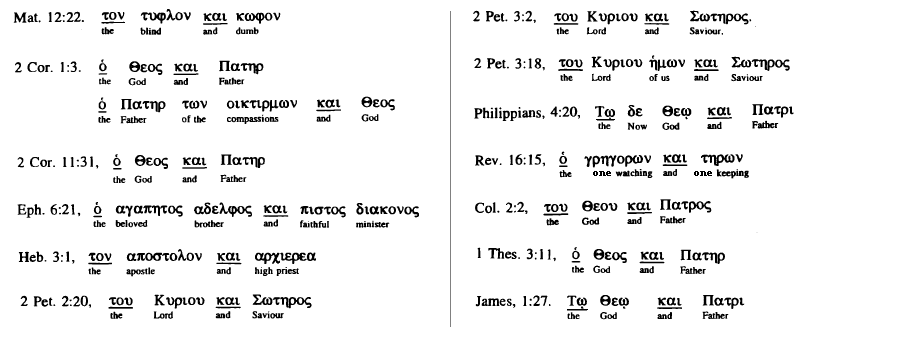|
Rule I. When the copulative kai connects two nouns of the same case, [viz. nouns (either substantive or adjective, or participles) of personal description respecting office, dignity, affinity, or connection, and attributes, properties, or qualities, good or ill,] if the article ho, or any of its cases, precedes the first of the said nouns or participles, and is not repeated before the second noun or participle, the latter always relates to the same person that is expressed or described by the first noun or participle: i.e. it denotes farther description of the first-named person, as -  And there is no exception or instance of the like mode of expression, that I know of, which necessarily requires a construction different from what is here laid down, EXCEPT the nouns be proper names, or in the plural number; in which cases there are many exceptions; though there are not wanting examples, even of plural nouns, which are expressed exactly agreeable to this rule. ... The rules which follow are intended only to illustrate the particularity of the several sentences which fall under the first rule, by showing, in other sentences, the different senses that are occasioned by adding, omitting, or repeating, the article, as well with the copulative as without it.
Rule II.  Except when genitive cases depend on one another in succession, as - 
Rule III. 
Rule IV. 
Rule V. 
Rule VI.  Except distinct and different actions are intended to be attributed to one and the same person; in which case, if the sentence is not expressed agreeably to the three first rules, but appears to be an exception to this sixth rule, or even to the fifth, (for, this exception relates to both rules,) the context must explain or point out plainly the person to whom the two nouns relate: as in -  Exceptions to the fifth rule, and in -
The various uses of the article and copulative, expressed in the last five rules and their exceptions, must amply illustrate, to every attentive reader, the difference and particularity of those sentences which fall under the first principal rule; and therefore I may now proceed with more confidence to point out several important corrections that ought to be made in our common translation of the New Testament, if the several sentences, which fall under the first rule, be duly weighed and considered; - corrections which may be fairly defended, I apprehend, by the authority of the several examples from which those rules were formed.
Notes on Sharp's Rules Sharp's rules are usually illustrated
with a three, four, or five letter designation, as follows: TSKS, TSTS,
TSS, SKS, TSKTS. Therefore, the first rule, where the construction in Greek is "article - substantive - kai - substantive" would be illustrated as a "TSKS" construction.
Rule I (TSKS, article - substantive - kai
- substantive {singular, personal})
Rule II (TSTS, article - substantive -
article - substantive {personal})
Rule III (TSS, article - substantive -
substantive {personal})
Rule IV (TSS, article - substantive -
substantive {non-personal})
Rule V (SKS, substantive - kai -
substantive {personal or non-personal})
Rule VI (TSKTS, article - substantive -
kai - article - substantive {personal or non-personal}) Many modern Greek Grammars include a section on Sharp's rule. Here is Vaughn's & Gideon's summary. "If two nouns of the same case are connected by a "kai" [and] and the article is used with both nouns, they refer to different persons or things. If only the first noun has the article, the second noun refers to the same person or thing referred to in the first." (Vaughn and Gideon, A Greek Grammar of the New Testament, Nashville: Broadman Press, 1979, p. 83.) You may notice that this version of
Sharp's first rule does not limit it to exclusively personal, singular
nouns, but also includes plural and non-personal nouns in the first
rule. Daniel B. Wallace (Greek Grammar Beyond the Basics, pp. 278-290)
has noted that when non-personal or plural nouns appear in a TSKS
construction, at least some kind of unity is being expressed between the
substantives. They may be: As a general exegetical rule, we have found that the following general rule is helpful. "TSKTS or SKS- If two nouns of the same case are connected by a "kai" (and) and the article is used with BOTH nouns (TSKTS), or with neither noun (SKS), the nouns point to different persons, things, or qualities. That is, the nouns are being distinguished in the context for a specific reason. This is true even when both nouns are applicable to the same person. eg., "I am the Alpha and Omega." The two nouns are opposites, and are being distinguished as extreme opposites, even though Jesus claims both for Himself. TSKS - If only the first noun has
the article, the second noun refers to the same person referred to in
the first when the nouns are singular,
personal, and not proper names. When only the first noun has the
article in plural or non-personal
constructions,
the nouns
are being united for a purpose. In this case, even though the
nouns themselves may individually refer to different things, qualities,
or persons, they are being united for a specific reason in the context.
For example, "the scribes and Pharisees." In this TSKS construction the
writer meant to unite the two groups in pointing out their common
opposition to Jesus, even though the two groups are completely distinct
individually. |

